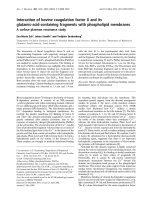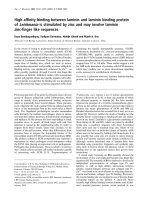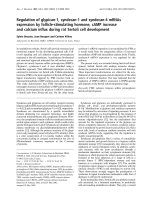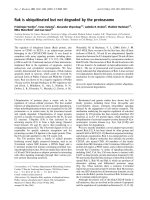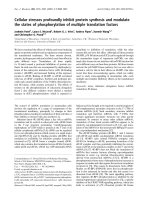Báo cáo y học: " Within you, without you: HIV-1 Rev and RNA export" ppt
Bạn đang xem bản rút gọn của tài liệu. Xem và tải ngay bản đầy đủ của tài liệu tại đây (310.63 KB, 4 trang )
BioMed Central
Page 1 of 4
(page number not for citation purposes)
Retrovirology
Open Access
Commentary
Within you, without you: HIV-1 Rev and RNA export
Andrew I Dayton*
Address: Center for Biologics Evaluation and Research, Food and Drug Administration, USA
Email: Andrew I Dayton* -
* Corresponding author
Abstract
Nucleo-cytoplasmic transport of RNA is one of many cellular pathways whose illumination has
progressed hand in hand with understanding of retroviral mechanisms. A recent paper in Cell
reports the involvement of an RNA helicase in the pathway by which HIV exports partially spliced
and unspliced RNA out of the nucleus. This suggests the ubiquity of RNA helicases in RNA export
from the nucleus, and has novel mechanistic implications.
HIV must export to the cytoplasm not only full length
genomic and structural gene-encoding RNA species, but
also partially and fully spliced RNAs which code for a vari-
ety of overlapping structural and accessory genes. Whereas
the fully spliced HIV RNA species readily exit the nucleus
and undergo translation, the partially spliced and
unspliced species require the interaction of the HIV-1 Rev
protein with the cis-acting, viral RRE (Rev responsive ele-
ment) for expression. Simpler retroviruses, such as the
type-D Mason-Pfizer monkey virus (MPMV) solve a simi-
lar problem by encoding a cis-acting, constitutively active
CTE (constitutive transporter element) in the 3'UTR of the
viral genome, which uses a distinct pathway [1,2]. Of less
clear significance is the existence of CRM-1 dependent
nuclear export signals in gag proteins of HIV and RSV. It is
theoretical possibility that shuttling gag proteins might
contribute to nucleocytoplasmic export of genomic RNA,
but it is equally possible that the only need for nuclear
export of gag is to overcome the nuclear targeting signals
late in viral replication [3,4]. Over the last seven years or
so, tremendous progress has been made in characterizing
nucleocytoplasmic transport pathways.
The Rev/RRE pathway involves the Ran-CRM-1, shuttling
system: In the nucleus, Ran-GEF converts Ran-GDP to
Ran-GTP. Ran-GTP bound CRM-1 binds the NES (nuclear
export signal) domain of Rev, which is in turn bound to
the RRE, and enables CRM-1 to transport the resulting
RNA/protein complex as cargo into the cytoplasm, pre-
sumably through CRM-1 interactions with nucleoporins.
In the cytoplasm, Ran-GAP converts Ran-GTP to Ran-
GDP, releasing the REV/RNA cargo. The asymmetric distri-
bution of Ran-GEF and Ran-GAP between nucleus and
cytoplasm ensures a constant RAN-GTP/GDP gradient to
facilitate CRM-1 recycling and continued Rev/RRE export.
CTE-mediated RNA export is based on binding to the Tap-
NXT complex, and export through an unrelated transport
pathway, which, ironically, is responsible for the bulk of
mRNA transport [2].
Enter the laboratories of Kuan-Teh Jeang and Larry Klei-
man, who, in a comprehensive study in the October 29th
issue of Cell, report the involvement of the RNA helicase,
DDX3, in the Rev/RRE pathway [5]. Interestingly, DDX3
attracted their attention in preliminary screens indicating
it was upregulated by the HIV-1 Tat protein, which is
directly involved in transcriptional, not post-transcrip-
tional regulation. Studying the effects of DDX3 overex-
pression, expression of dominant negative DDX3
mutants, or antisense knockdown of DDX3, variously on
Published: 29 October 2004
Retrovirology 2004, 1:35 doi:10.1186/1742-4690-1-35
Received: 28 October 2004
Accepted: 29 October 2004
This article is available from: />© 2004 Dayton; licensee BioMed Central Ltd.
This is an Open Access article distributed under the terms of the Creative Commons Attribution License ( />),
which permits unrestricted use, distribution, and reproduction in any medium, provided the original work is properly cited.
Retrovirology 2004, 1:35 />Page 2 of 4
(page number not for citation purposes)
expression of Rev/RRE dependent reporter genes, Rev/RRE
dependent subgenomic HIV constructs, or full length HIV
genomes, Yedavalli et al. determined that in all cases,
DDX3 had effects consistent with its playing a significant
role in Rev/RRE dependent expression. These effects
included expression of proteins, and nucleocytoplasmic
partitioning of Rev/RRE dependent and Rev/RRE inde-
pendent RNAs. In parallel studies, they determined that
DDX3 had no effect on expression from CTE dependent
constructs.
A number of findings not only provided evidence consist-
ent with a role for DDX3 in the Rev export pathway, but
also provided mechanistic insights. DDX3, though consti-
tutively cytoplasmic, shuttles between nucleus and cyto-
plasm in a manner dependent on CRM-1, as evidenced by
inhibition by leptomycin B (LMB), which inhibits CRM-1
export, but not Tap export. DDX3 also localizes to nuclear
outer membranes in a speckle formation and co-immuno-
precipitates with nucleoporins, in addition to having a
distribution in the cytoplasm. In cell lysates, DDX3 co-
immunoprecipitates with either Rev protein or CRM-1.
Although the studies on cell lysates fail to distinguish
between pairwise binding and ternary complex forma-
tion, ternary complex formation is a distinct possibility.
DDX3 directly binds CRM-1 in vitro (in a manner inde-
pendent of its NES). Although no data are presented con-
cerning direct in vitro binding of DDX3 to Rev, for such an
interaction to exist and to be significant, DDX3 would
have to bind one of the three identified functional regions
in Rev. These include the NES, the coincident NLS/RBD
(nuclear localization signal/RNA binding domain) and
the Rev multimerization domain, which flanks the RBD
[6]. No regions in Rev besides these have been identified
by mutagenesis or by any other techniques to be critical
for function. Such an interaction would seem unlikely
(though not impossible) in a complex of oligomerized
Rev bound to RNA and CRM-1. Conceptually it might be
easier to accommodate all the binding interactions in
some kind of "pass-along" mechanism. This could allow
some of the binding interactions to take place sequen-
tially, rather than simultaneously.
In the tradition of good research, the results of Yedavalli
et al. [5] pose as many questions as they answer. Though
the binding interactions so far discovered, and DDX3's
ability to shuttle between nucleus and cytoplasm could be
consistent with a quarternary complex of Rev, RNA, CRM-
1 and DDX3, the existence of such a complex remains to
be proven (and the authors avoid implying its existence).
It is possible there is some sort of "pass along" mechanism
in which some of the binding interactions are sequential.
It is tempting to suggest that DDX3 plays a role in reliev-
ing torsional tension to facilitate RNA passage through a
confining nuclear pore, or that it helps remove certain
proteins from RNA before, as, or after it reaches the cyto-
plasmic side of the nuclear membrane. Two other heli-
cases have been implicated in RNA nuclear export
pathways. In yeast, Dbp5p helicase, binds nucleoporins,
localizes to nuclear pore complexes on the cytoplasmic
side of the nuclear membrane, and is involved in mRNA
export [7-9]. RNA helicase A (RHA) has been implicated
in CTE-mediated transport [10-13]. A general requirement
for RNA helicases in RNA transport is an attractive con-
cept. Conceivably they could even be a significant molec-
ular motor contributing to RNA transport: some RNA
helicases are highly processive [see [14] and references
therein] and may work by translocating along ssRNA, dis-
placing bound RNA and protein (the "snowplow"
model). At least one highly processive RNA helicase has
been show to displace tightly bound protein from dsRNA
[15]. An energy-dependent, highly processive RNA heli-
case tethered to the cytoplasmic side of the nucleopore
could thus pull a long RNA molecule through the pore
(see Figure 1). Theoretically this could solve the problem
of how to get the rest of the RNA through the pore once
the region initially targeted by CRM-1 (the RRE in the case
of HIV) is transported and released. Other possibilities
could, of course, include other molecular motors such as
kinesin, in association with protein/RNA complexes [16].
On a highly speculative note, the intimate involvement of
a DEAD box helicase in the Rev pathway, and the observa-
tion that DDX3 has a cytoplasmic localization, in addi-
tion to its nuclear membrane localization, recalls some
old data from two independent laboratories, indicating
that in some systems Rev may not act on export, but on
post export events, to promote Rev/RRE dependent
expression [17,18]. The eIF4A family has been called the
"godfather" of DEAD box helicases [19]. EIF4A3 can be
targeted to the exon junction complex of spliced mRNA,
and it has been speculated that it may have a splicing-
dependent influence on mRNA translation [20]. In cell
types where Rev does not act through export, could it act
by specifically targeting to the ribosome a related DEAD
box RNA helicase, translation initiation factor? Time will
tell.
Finally there is the possibility that specific helicases will
be valid therapeutic targets for antiretroviral chemother-
apy. Although targeting a cellular gene involved in a viral
pathway risks inhibiting a necessary cellular function, it
avoids the overwhelming problem posed by rapid viral
mutation to resistance.
Abbreviations
RRE: Rev Responsive Element
MPMV: Mason-Pfizer monkey virus
Retrovirology 2004, 1:35 />Page 3 of 4
(page number not for citation purposes)
Schematic diagram outlining Rev mediated RNA export from nucleus to cytoplasmFigure 1
Schematic diagram outlining Rev mediated RNA export from nucleus to cytoplasm. a, Viral RNA develops secondary structure
before binding critical protein components of the export pathway. b, Rev protein binds the RRE, forming a complex of REV,
viral RNA, CRM-1 and DDX3, which begins to unwind secondary structure. c, The export complex enters the nucleopore,
where both CRM-1 and DDX3 interact with nucleoporins. d, Even after CRM-1 and Rev are released from the export com-
plex, DDX3 may still pull RNA through the complex by virtue of its processivity.
Publish with BioMed Central and every
scientist can read your work free of charge
"BioMed Central will be the most significant development for
disseminating the results of biomedical research in our lifetime."
Sir Paul Nurse, Cancer Research UK
Your research papers will be:
available free of charge to the entire biomedical community
peer reviewed and published immediately upon acceptance
cited in PubMed and archived on PubMed Central
yours — you keep the copyright
Submit your manuscript here:
/>BioMedcentral
Retrovirology 2004, 1:35 />Page 4 of 4
(page number not for citation purposes)
CTE: Constitutive Transport Element
NES: Nuclear Export Signal
LMB: Leptomycin B
NLS: Nuclear Localization Signal
RBD: RNA Binding Domain
Competing Interests
None. The opinions expressed are those of the author and
do not necessarily express the opinion of the FDA.
References
1. Harris ME, Hope TJ: RNA export: insights from viral models.
Essays Biochem 2000, 36:115-127.
2. Cullen BR: Nuclear RNA export. J Cell Sci 2003, 116:587-597.
3. Scheifele LZ, Garbitt RA, Rhoads JD, Parent LJ: Nuclear entry and
CRM1 dependent nuclear export of the Rous sarcoma virus
Gag polyprotein. PNAS USA 1999, 99:3944-3949.
4. Dupont S, Sharova N, DeHoratius C, Virbasius C-MA, Zhu X, Bukrin-
skaya AG, Stevenson M, Green MR: A novel nuclear export activ-
ity in HIV-1 matrix protein required for viral replication.
Nature 1999, 402:681-685.
5. Yedavalli VSRK, Neuveut C, Chi Y, Kleiman L, Jeang K-T: Require-
ment of DDX3 DEAD box RNA-helicase for HIV-1 Rev-RRE
export function. Cell 2004, 119:381-392.
6. Pollard VW, Malim MH: The HIV-1 Rev protein. Annu Rev Microbiol
52:491-532.
7. Snay-Hodge CA, Colot HV, Goldstein AL, Cole CN: Dbp5p/Rat8p
is a yeast nuclear pore-associated DEAD-box protein essen-
tial for RNA export. EMBO J 1998, 17:2663-2672.
8. Tseng SS, Weaver PL, Liu Y, Hitomi M, Tartakoff AM, Chgang TH:
Dbp5p, a cytosolic RNA helicase, is required for poly(a)+
RNA export. EMBO J 1998, 17:2651-2662.
9. Schmitt C, von Kobbe C, Bachi A, Pante N, Rodrigues JP, Boscheron
C, Rigaut G, Wilm M, Seraphin B, Carmo-Fonesca M, Izaurralde E:
Dbp5p, a DEAD-box protein required for mRNA export, is
recruited to the cytoplasmic fibrils of nuclear pore complex
via a conserved interaction with CAN/Nup159p. EMBO J 1999,
18:4332-4347.
10. Tang H, Gaietta GM, Fischer WH, Ellisman MH, Wong-Staal F: A cel-
lular cofactor for the constitutive transport element of type
D retrovirus. Science 1997, 276:1412-1415.
11. Tang H, Xu Y, Wong-Staal F: Identification and purification of
cellular proteins that specifically interact with the RNA con-
stitutive transport elements from retrovirus D. Virology 1997,
228:333-339.
12. Westberg C, Yang JP, Tang H, Reddy TR, Wong-Staal : A novel shut-
tle protein binds to RNA helicae A and activates the retrovi-
ral constitutive transport element. J Biol Chem 2000,
275:21396-21401.
13. Tang H, Wong-Staal F: Specific interaction between RNA heli-
case A and Tap, two cellular proteins that bind to the consti-
tutive transport element of type D retrovirus. J Biol Chem 2000,
275:32694-32700.
14. Bizebard T, Ferlenghi I, Dreyfus M: Studies on three E. coli
DEAD-box helicases point to an unwinding mechanism dif-
ferent from that of model DNA helicases. Biochemistry 2004,
43:7857-7866.
15. Jankowsky E, Gross CH, Shuman S, Pyle AM: Active disruption of
an RNA-protein interaction by a DExH/D RNA helicase. Sci-
ence 2001, 291:121-125.
16. Kanai Y, Dohmae N, Hirokawa N: Isolation and Characterization
of an RNA-Transporting Granule. Neuron 2004, 43:513-525.
17. Arrigo SJ, Chen IS: Rev in necessary for translation but not
cytoplasmic accumulation of HIV-1 vif, vpr, and env/vpu-2
RNAs. Genes Dev 1991, 5:808-819.
18. D'Agostino DM, Felber BK, Harrison JE, Pavlakis GN: The Rev pro-
tein of human immunodeficiency virus type I promotes poly-
somal association and translation of gag/pol and vpu/env
mRNAs. Mol Cell Biol 1992, 12:1375-1386.
19. Rogers GW, Komar AA, Merrick WC: eIF4A: the godfather of
the DEAD box helicases. Prog Nucleic Acid Res Mol Biol 2002,
72:307-331.
20. Chan CC, Dostie J, Diem MD, Feng W, Mann M, Rappsilber J, Drey-
fuss G: eIF4A3 is a novel component of the exon junction
complex. RNA 2004, 10:200-209.




